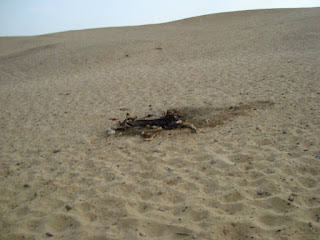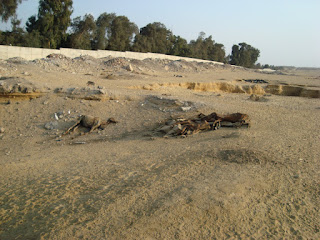
I have people contact me through my website all the time saying that they are coming to Egypt and have always dreamed of riding a horse "at the pyramids". I always write back asking "which pyramids?" although I know that they are referring to the big ones, the pyramids at Giza, The Pyramids. I point out that the last count I saw was that Egypt had about 120 pyramids and that there are much nicer pyramids for riding than those at Giza. I'm sure that Dr. Zahi Hawass, the head of the Supreme Council for Antiquities, would agree with me since he's certainly made it more difficult to ride a horse to Giza.

I live about ten miles south of the Giza plateau, roughly halfway down a line of most of the pyramids in Egypt. I can see the pyramids of Abu Sir from my garden, and a nice view of Giza across green fields (an amazing sight and one that is getting harder and harder to see daily) is available about 10 minutes away on horseback, weather permitting. The Step pyramid at Sakkara can be seen from a nearby vantage point from the fields, and even better there is a hill behind Abu Sir from which on a clear day you can see Giza, Abu Sir, Sakkara, and Dahshur...roughly 80% of the pyramids in Egypt. Of course we have to hope for decent weather and low pollution from the city, which is getting more infrequent also on a daily basis, but that's a different story. So my question is legitimate and my advice is usually that Giza is best seen by car and then riding be done in more horse-friendly areas.
I recently had a visitor from Costa Rica and he and I decided to ride to Giza from the farm to see what effects the Antiquities Council's new security measures had on being able to ride to the pyramids there. The ride up there isn't bad really, as long as you stay far enough away from the army base at Beni Yusef. They were having maneuvers or competitions or something that day and we rode north to the accompaniment of artillery fire, making a safe distance even farther as far as I was concerned. I had no idea what they were shooting....live shells or what?...and had no wish to find out. The horses were infinitely less concerned with the racket than we were, which was a relief. When we came within sight of the "closed" portion of the Ring Road, a section that was supposed to circle around behind the Giza plateau but that was never finished due to opposition from UNESCO and the Antiquities Council, we received our first unpleasant surprise. Although the road is just a dirt road, the traffic on it is heavy. Trucks, cars, dump trucks, you name it...they are all traveling on the road as if it were a standard highway. Many of the cars are those of the police so acceptance of this non-road seems to be fairly universal. The reason for the traffic lies in the incredible jam at the roundabout where the Alexandria/Cairo desert highway, the Fayoum highway, and Pyramids Road/Faisal Street all meet near the site of the new Egyptian museum. On a normal day a car can sit there for almost an hour, so it's no wonder that motorists have sought alternatives. To be fair, the government is building an extension to the Ring Road that will connect these areas without using the pyramids area, but it isn't completed yet and who knows if the traffic will lessen when it is done.

So after picking our way cautiously across the traffic, we entered the desert that leads to the plateau. This desert was at one time home to some weekend cottages for the well-connected but they have been bulldozed many years before. Unfortunately the clean-up never quite finished and there are areas where concrete floors still cover the desert sand and piles of rubble remain. As we made our way down the sandy washes towards the wall that now surrounds the Giza antiquities area we first began to be a bit uneasy. Dark spots on the sand in the distance attracted the horses' attention initially and then ours. Closer inspection revealed them to be the remains of horses lying in the sand.

I don't take inexperienced riders to Giza. It isn't such a tough ride as such, but the way that the clients of the Nazlit Semman stables careen across the sands pursued by whip-wielding grooms with little or no control of the horses makes me worry about the safety of my horses and clients. I warn people to assume that any horse heading for them has every intention of running them down...defensive riding is definitely the order of the day.

On this particular day, the riders were, for the most part, fairly calm, but the dead horses that we had to pass on our way in were evidence of the fact that plenty of others hadn't been. Horse carcasses lined the wash as we walked down towards the entrance to the stables area of Nazlit Semman. Most of them looked to be a week or so old at least, horses who had dropped in their tracks as they were on their way back to the stables and the bodies had been left for the kites, crows and desert dogs to dispose of. The Equine Influenza outbreak had been particularly fierce in this area this summer, hardly surprising since the horses live in crowded conditions and are usually in poor condition, and I suspect that many of the bodies we were seeing were horses who had never had the chance to recover before having to work. I know that my horses who were in good health before the outbreak took a long time to be feeling energetic and happy again. We let them rest for at least a month before any were ridden and then they were worked very gently for the next month...short hours, short distances, and slow speeds.

Once in the stables area we discovered that the new security measures meant that we all had to buy tickets to the pyramids (before a little baksheesh had given entrance), and my groom, who was accompanying us on a training ride for one of the younger horses, was only allowed in once the police decided that he did not work in the immediate area. Only local personnel from a particular list are allowed in now. Once inside we rode up to the three large pyramids (and a number of smaller ones) enjoying the fact that the area was relatively uncrowded, but still not horse carcass free. However, the areas in which we could ride appeared to be rather restricted unlike before. It was not entirely clear what the rules were, since we got different versions from the various police guards and other horse people.

On our way back out we decided to cut the body wadi out of the route and head home through the countryside which took us past an area that seems to be used as a dump by the stables and local inhabitants. There we made our way past a man hauling a painfully thin dead white horse out to the desert on a wooden wagon and then past an area where a fairly recently dead chestnut horse marked a pile of at least six other bodies and a set of feet that protruded from a blackened pile of debris indicating that someone had used old tires to try to burn a horse's body nearby. It wasn't much of an improvement. Our spirits didn't really rise again until we'd made our way down to the familiar dirt roads of the countryside, having negotiated with a fair bit of difficulty the rush hour traffic on the road that isn't there.

For myself, I will be happy never to ride to Giza again, and my warnings to fellow riders about what kind of things will be seen are clear and blunt. It's much better to go there by car and avoid all of that. It would be even better to see someone help the poor horses who work in horrible conditions, but how that will happen is beyond me, unless the stables simply close due to lack of customers. To be fair, there are some very nicely kept horses there, but I have to wonder at their mental state. My horses find the experience of being in the presence of so much pain and fear quite unsettling. They can deal with chaos, cars, noise and traffic with complete calm, but the fear and pain unhinge them a bit and their relief at leaving the area is so clear.
copyright 2008 Maryanne Stroud Gabbani






6 comments:
Hello Maryanne, I was delighted to see a new post on your blog, I recently discovered it - read all the previous posts, enjoyed your photos, and eagerly awaited new entries. Your story of the "pyramid horses" fits my theme of the day, horses suffering from their association with humans. Thanks for the warning and for your window into a world far removed from Humboldt County, California.
Cherie
Well, that was depressing. Let's not do that ride next time I come to visit. I'm going to go hug my horse right now.
Interesting post, and excellent blog!
Dear Lord...what would have happened to that poor white horse that would leave him so thin? *shaking head* I often forget how hard some aspects of Egyptian life are...dead buffalo and horses in the canals. sigh.
The fact that there are horses that get hit by trucks or overworked unto death is really sad. But where you find working animals, you find poorly treated animals sometimes.
There, oddly enough, is a good reason for putting the body of a donkey or horse in the canal. The water table in the Nile Valley is so high that you can't dig down to bury anything without hitting water and poisoning all the plant life nearby. Most of the owners of horses, donkeys, and buffalo do not have an extra LE 100 or more around to pay someone to haul a carcass out to the landfill that is usually in the desert outside the valley. And the carcasses aren't welcome there anyway as they attract wild dogs who can be very enthusiastic in their defence of a food source. So the bodies often are put into the canals. This water is destined for irrigation rather than consumption and the canals are full of fish, crayfish, and birds that do an excellent job of disposing of the carcasse in about 2 weeks. It isn't a very aesthetically pleasing method of disposal, but it is economical and effective.
Maryanne,
As always, I was impressed by your depth of knowledge about Egypt.
After working where I did for so long, answering thousands of questions about Egypt, I was dismayed by the lack of knowledge, understanding and compassion so many visitors and ex-pats had about Egypt.
So few ventured into the country or had Egyptian friends. What they missed!
Well, I miss it and you!
The Other Mother
Post a Comment